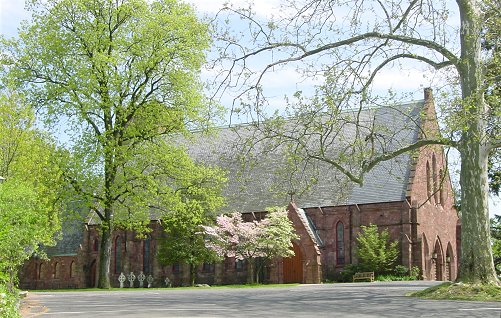
Whitemarsh Part 2

Modern St. Thomas Church

Looking North From Below St. Thomas Church
Starting at around 10pm on the night of December 4th, Howe's approximately 10,000 men marched from Philadelphia toward Whitemarsh in two columns under Cornwallis and Knyphausen. The British skirmished with American troops along the way, but most significantly, at about 8am on December 5th, Cornwallis's column met around 600 Pennsylvania militia at Chestnut Hill north of Germantown in modern Erdenheim. The militia attacked, and the commander, General Irvine, and around 16 others, were captured. The militia withdrew.
Howe and his men reached St. Thomas church on a small hill in Whitemarsh and camped there for the night. The next morning, December 6th, Howe observed the American position from the church tower. About half a mile to his left, and behind Wissahickon Creek, was Militia Hill. Half a mile to his front was Camp Hill, with Sandy Run, a tributary of the Wissahickon, flowing behind it. A mile to Howe's right was Camp Hill. Washington's army defended fortifications on all of these hills. Howe ordered his artillery near the church to bombard the American positions, but it was entirely ineffective.

From Militia Hill
This is the view looking southeast, toward Edge Hill, from about a third of the way up Militia Hill, which rises about 170 feet above Wissahickon Creek. Seeing the futility of attacking the strong American position directly, Howe determined to attack the American left. So Howe fell back and began shifting troops to his right, or east, in two columns. The Americans, however, could observe enemy movements from higher ground and shifted troops accordingly.
That night, Howe brought the majority of his army from Philadelphia through Germantown to Edge Hill. On the 7th, a diversion under General Grant fought the Pennsylvania militia under General Potter along with the 2nd Connecticut Regiment on Waverly Heights, or Edge Hill. A few hours later, the main column under Cornwallis met Dan Morgan's riflemen and Mordecai Gist's Maryland militia on Edge Hill. The British light infantry was repulsed, but Cornwallis's favorite regiment, the 33rd, pushed the Americans back to Camp Hill.
Nevertheless, Howe could see that the
American position was too strong. At 3:30 on December 8th, the British
began to return to Philadelphia via Branchtown. Despite occasional
skirmishes, the British arrived in Philadelphia by 10:30.
With December well underway, it was past time for
Washington's army to go into winter quarters. Wilmington, Delaware had
been considered for winter quarters, as was dispersing the army through Pennsylvania, but Washington
wanted to stay near Philadelphia in order to hinder British supply efforts.
He considered remaining at Whitemarsh, but it was vulnerable to surprise attack.
Finally, a safer site further distant, and on the other side of the Schyulkill,
Valley Forge, was
decided upon. After clashing with Cornwallis again at Matson's Ford near
modern Conshohocken, the army arrived at their new winter quarters on
December 19th.
Acknowledgement:
Many thanks to Bob Fanelli of the Philadelphia area, who provided information and advice with the writing of this section of the webpage. Any errors, however, are my own.
Back to Revolutionary War Virtual Battlefield Tours